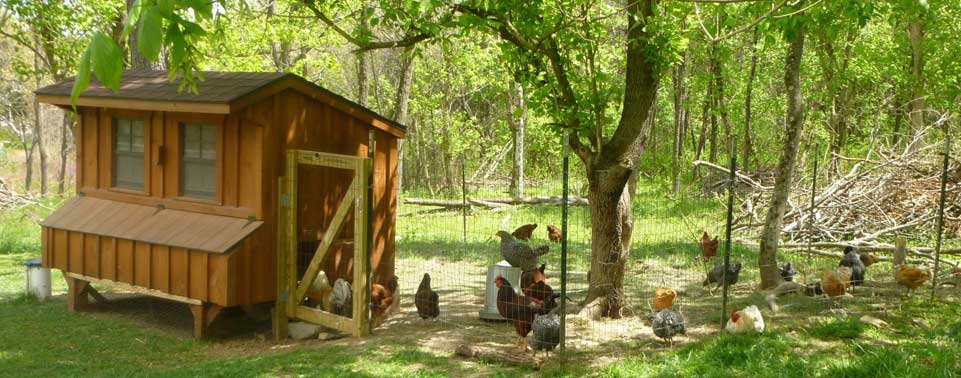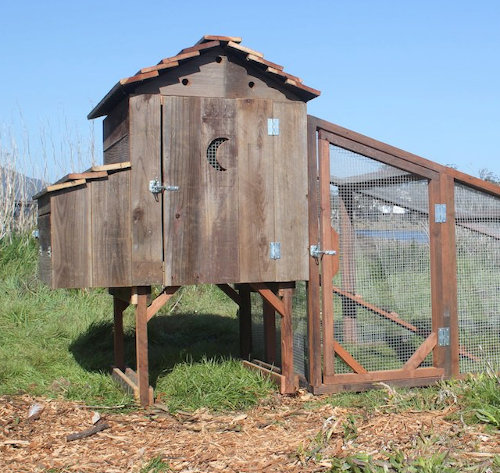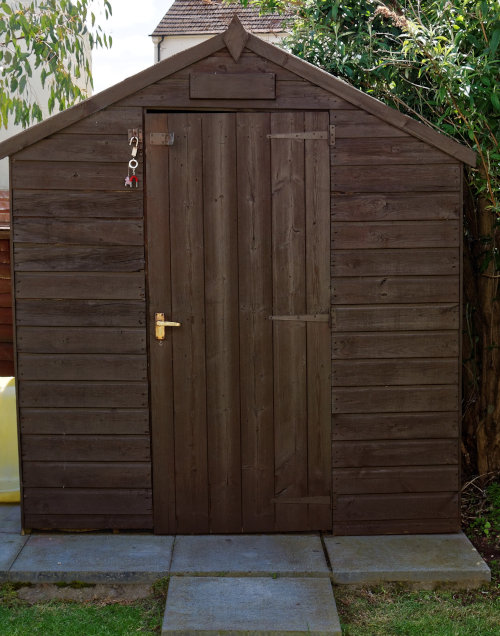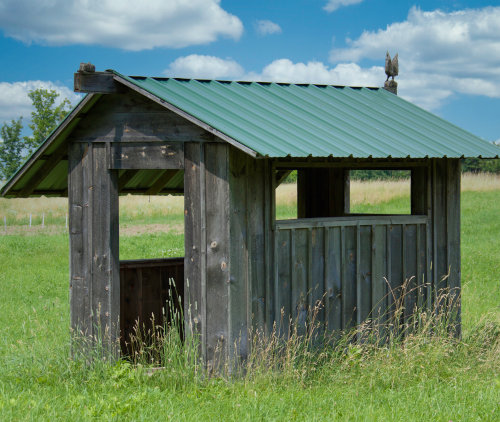The chicken coop roof.

Do I need a roof on my chicken coop?
A chicken coop does need a waterproof roof of some kind to keep the weather and predators out. Chicken coop roofs are also useful for collecting water to keep the flock hydrated and overhangs are useful for shelter both from the weather and the sunshine.
Below: A chicken coop roof can be simple as well as effective.

How high does a coop roof need to be?
The roof in a house should be high enough to allow plenty of air-circulation and also ease of working. Single-boarded and tightly covered with good roofing felt, shakes, or shingles is all that is required for a roof in a successful house. Shingle roofs should be one-third pitch, but roofing-paper will be satisfactory with almost no pitch.
The roof of a coop should be at least 3 foot above the perches. Here in the UK it is the law that chickens should have 45 cm or nearly 20 inches of head space above them. This is a good standard if you are planning to build your own coop.
A shed roof does not require tie-beams, but with the combination pitch it is desirable to use them on account of the weight of the roof, especially when covered with snow.
Why do chicken coops have slanted roofs?
Hen houses often have slanted roofs because this means water and snow do not collect on the roof. Ice can build up on completely flat roofs leading to failure.
Raising one side of the roof to create a slant is an excellent way to increase the ventilation in a chicken coop.
Below: Showing the angle of the roof of a shed type chicken coop.

Slanted roofs are easier to clean.
Should a chicken coop roof have overhangs?
Overhangs are very handy for keeping precipitation out of the coop and away from the walls and will help preserve the timber for longer.
A good chicken coop has ventilation high up the walls, near the roof. If your coop doesn't have an overhang, rain and snow can get blown into the coop through the ventilation holes.
Below: Large overhangs mean shelter for you flock.

Overhangs allow easy fixing of guttering to channel the water away which helps to keep the run dry.
A large overhang can also provide shelter for the hens if you don't have a covered run.
What angle should roof be?
Definitions vary on when a roof is considered pitched. In degrees, 10° (1 in 6) is considered a minimum. The primary purpose of pitching a roof is to redirect water and snow. Thus, pitch is typically greater in areas of high rain or snowfall.
The roof pitch or angle of your chicken coop will depend on how much rain and snow you get in your location but should be at least 5° for areas that never get snow or ice and at least 30° for areas that experience heavy snow fall or prolonged periods of freezing weather.
If you use boards on the roof, they should be brought together so there is no gaps. In many instances dampness in the hen house is caused by allowing spaces between the boards whilst tight boarding helps to prevent this.
Below: Anything from 10 to 30 degrees slope on the roof is fine and easy to achieve.

I would suggest that the roosting-quarters be sheathed on the inside of the house in the more damp sections of the country.
Roughly the same amount of material is required for either the shed, gable, or combination pitch type if the pitch and floor-plan are similar. The greater the pitch, the more material is required both to frame and cover the roof.
Type of chicken coop roof:
Common chicken coop roof options include:
- Shed style roof. This is the two sloping sides leading up to a pointed roof which has the advantage of being simple, easy to construct and maintain and effective.
- Flat roof. The coop roof should never be completely flat as water needs to run off but if you get no snow a flat roof inclined at 5° (1 in 12) will be
Chicken run roof materials:
The most common roofs are made from:
- Sheet corrugated metal.
- Plastic sheeting ( can be insulated).
- Timber (Plywood) and shingle.
For a DIY or cheap roof for chicken coops you might want to look into recycled pallets.
Does a chicken run need a roof?
The run is their outdoor space and it needs to be enclosed for safety reasons but not necessarily covered.
Runs can be covered with mesh to keep hawks and the like out but they don't need a roof like the chicken coop does.
Covering a chicken run with a roof is going to cost a lot but mesh is cheaper.
